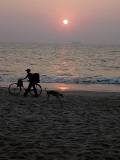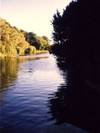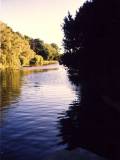From time to time I get a few queries about my photographs, my camera and techniques.
I don't really know what I'm doing, having never studied photography, or Art, for that matter, so everything I do is trial and error.
I have always enjoyed photography and since going digital four years ago I have found the wherewithal to expand that enjoyment. The start-up costs of digital are much greater than film, but the incremental costs are negligible. With film, every shot taken costs money, for replacing the film and for D&P. Both times I visited Niagara Falls, I thought I had gone OTT by shooting an entire roll of 36 exposures. A three week holiday in the US came to five and a half films. In contrast, I feel that the thirty seven shots I took in Dublin on Wednesday were a meagre return; I took the equivalent of 5½ on what was basically a beach holiday in Egypt.
The downside of this is in general a lot of crap and repetitiveness, the upside is the confidence to take shots that I suspect will not turn out, but sometimes produce miraculous results. It also means far more opportunity to record the everyday, which, again, risks being boring, but in time may prove to be fascinating documentary. Going back 50 or 100 years , people generally only took photos of special occasions, in artifically posed groups, with artifical smiles.
The digital revolution has truly democratised photography in a way that few people could have seen as possible - or necessary - ten years ago. The fact that I can publish my photos to the world, hopefully giving pleasure to complete strangers never crossed my mind until very recently.
I was surprised at how many shops are advertising printing straight from memory cards - to me, one of the great things about digital is being able to manipulate the images on the PC. My cousin claims he has no use of photo-editing software, because every photo he takes is perfect. I would suggest he never takes chances!
On the whole I don't do a great deal of editing. I do a lot of slight rotating - I have a tendency to take photos that are not quite perpendicular. I try very hard to correct this by identifying a straight line on the screen, but when I'm pointing-and-shooting I just don't have the luxury of time. When I used film, I tended to have the subject accidentally off-centre, to the left. I also crop pretty freely - eliminating peripheral nonsense can transform a mediocre picture into a very good, or even, great picture.
I use MGI Photosuite, which I have read described as entry level, and I suppose I ought to be past Entry-Level. Indeed I have tried using Photoshop Limited Edition, and my brother-in-law even downloaded me a pirate version of Photoshop. But, although this is said to be the best software, and does contain some amazing special effects, I feel a lot happier with Photosuite.
I generally 'enhance' the photo, which is similar to Photoshop's Auto-levels, and I often sharpen, which makes the edges more precise. Although, with pictures of people, I find 'soften' or 'remove scratches' gives a better effect. The clone tool can be useful, although I use it sparingly - eg one shot taken from a boat was marred by a thin rope bisecting the photo. It's laborious to get it right but on occasion it can transform the shot. It's also useful for zapping annoying people who wander into the edge of the frame.
As for camera, I have a Canon G3, which has been superseded by the G5. It has been described as the best 'amateur level' digital camera and suits my needs perfectly. It has a 4 Megapixel capacity, which is plenty big enough. Some prat was boasting to me the other day that his camera was 5 Megapixels, but I don't see any advantage. I generally shoot at 1600x1200, which comes out at less than 2 megapixels. In certain circumstances - where I suspect I might want to magnify details - typically with 'performance' pictures - I go for 2272 x 1704, which is still less than 4 megs. There is some trade-off even then. If you have shot in portrait mode, Windows shows it in landscape, but if you click rotate it says "Because of the dimensions of this picture, rotating it might permanently reduce its quality." Under those circumstances I rotate in Photosuite. I find that at 2272, the photo tends to appear more grainy than at 1600.
About 18 months ago Marcie asked for my thoughts comparing my G3 with a Nikon I had on loan after I dropped my G3 (...!). I wrote:
I have a Canon G3 - which I luv, and call 'My Baby'. I had loan of a Nikon Coolpix 5000. The spec of the G3 is better (eg 4x optical zoom, up to 14x digital as compared to 3x up to 7x on the Nikon), and I find the controls more me. The minus points are an ultra-sensitive on switch, and rather too many different menus. The Nikon is lighter and probably better suited to my very small hands (I can't stretch an octave on a piano), also arguably, slightly more stylish looking in black than the rather clunky silver of the G3.
What I like about the G3 is that there is an easy-to-use dial that
switches between Movie-Nightsight-landscape-portrait-fully auto
-programmable-Aperture priority - Shutter priority -stitch assist. These modes combine the ease of point-and-shoot with a little bit more customability. Whereas, the Nikon requires selecting one of three custom settings from the menu and doesn't have stitch assist.
The manual focus is more intutive on the Nikon, and it has a function
where you can take three consecutive shots at -1, 0, +1 exposure
compensation. On the down side, it has something weird where the macro has to be taken with shutter delay (which, apparently, is good practice, but...). The Nikon's manual is much more helpful.
The Canon comes with a remote control, which has its uses...
A major plus point with the Canon is that the battery doesn't have to be exhausted to be recharged, whereas with the Nikon it does. The Nikon battery is recharged in a separate charger, whereas the Canon has to be done from within the camera. The Canon battery life is longer, anyway.
In the UK, the Canon retails at about £100 (about $150) more than the Nikon.
Lyle has recently posted on Digital SLRs, but I have never been interested in SLR, partly because the ones I have tried have alwas seemed too heavy.
As for taking performance photos, it can be a bit hit-and-miss. The first thing to consider is that, strictly speaking, it is forbidden in many venues. I have heard stories of perpetrators being ejected or their cameras, or film, being confiscated. If you took and published photos for commercial gain, the venue or the promoters would be within their rights to sue.
There are some basic rules to follow, a mixture of common sense and good manners. It's best to smuggle the camera in the inner compartment of a handbag - don't make it too obvious or some jobsworth will stop you. Don't use flash when the performance is under way - it can be very distracting to the performers and also to other members of the audience. There are occasions when it seems okay, but I would err on the side of caution. Having paid good money to see specific performers I wouldn't want them distracted, and being that they are people I like, I would be mortified at the thought that they might be cursing that awful woman with her camera.
I was at once in the stalls at the RFH and someone was using flash from the circle, which distracted me. At the interval an announcement came not to use flash photography. This was greeted with very loud and enthusiastic applause. It is very rare nowadays to go to a concert where flashes don't go off at applause time, and I'm sure that most performers regard that as an alternative but valid form of applause.
To get the best pictures requires practice - don't wait until you see your favourite, but practice on others first. I have found that the two most important factors are to have a wide aperture and a fast ISO, the wider and faster the better. If I set the aperture at f2, and then zoom into about 5 or 7x, the camera forces the f number up. Looking at the photos I took on Wednesday, the f numbers are hovering around the f3 mark, the shutter speed was decided by the camera (but I could have set it independently) at between 1/50 and 1/200. I generally don't force the digtial zoom beyond about 7 because I usually entirely misfocus beyond there. The other thing to remember if you want accurately to record the data of your photos is not to have the camera set to Egyptian Standard Time...!
And finally, when taking photos of your hero it can be very disconcerting when he spots you and decides to flirt with you. All semblance of trying to be a serious photographer disappears and you are left a trembling wreck...(thank you, Señor Domingo - not that I'm complaining...!)









Comments